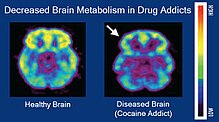بلية
لبلية (ب النڭليزية addiction، ب لعربية إدمان) هوّ إضطراب نيوروپسيكولوجي لي كيتميّز ب رغبة قوية لي كاتعاود ترجع بزاف و بشكل مداوم ف تخدام ؤلا ستيهلاك ؤلا مديار شي حاجة لي كاتعطي لپليزير، ب واحد الشكل لي كيضر لواحد لي مبلي (ب النڭليزية addicted، ب لعربية مُدمِن) وخا يكون واعي ب داك الضرر. هاد لمصطلح كيتخدّم بزاف ف سياق لهضرة على لاضروڭ و مواد كيماوية بحال النيكوتين لي كيكون ف لڭارو، ولاكين كينطابق تا على نواع خرين د لبلية، منهوم لبليات د لمديار (ب النڭليزية behavioral addictions)، بحال كترة تخدام لأنتيرنيت، لقمر، و لكونصوماج ب الزايد ديال اللوعاب د التيليجو ؤلا لپورنو.[1] لمواد لكيماوية لي كاتبلي لواحد سيرتو كيكون عندها تأتير على لخدمة د لمخ،[2] بحيت كاتدير لهيشة (ب النڭليزية craving) ف بنادم باش يكونصوميها و كاتضعّف لقدرة ديالو على التحكم ف راسو، وخا ماكاتحيّدهاش ف مرة.[3]

من بين لمضاهر لمعروفة ديال لبلية كانلقاو رغبة قهرية (ب النڭليزية compulsive desire) باش لواحد يتعاطى ل ديك لبلية، يعني بلي لواحد ماكيقدرش يحبس راسو منها، التفكير لمداوم ف ديك لبلية و كيفاش لواحد يقدر يخدّمها ؤلا يكونصوميها، و لإستمرار ف التعاطي ل لبلية وخا يكونو عندها نتائج مامزيانينش. لعادات لي كيديرو لبلية ف لعادة كيجيبو لپليزير فيساع،[4][5] ولاكين النتائج لخايبة ديالهوم كيجيو معطّلين، و داكشي علاش كيشدّو ف لواحد.[6][7]
يلاه الدليل التشخيصي دي إس إم-5 لي كيعتابر لبلية ب لقمر من بين لبليات د لمديار، ولاكين أي سي دي 11 كيدخّل تا لبلية ب اللوعاب د التيليجو ف هاد لإطار. لبليات د لمديار لخرين باقين مامعتارفش بيهوم علمياً كا بليات، ولاكين كيدخلو ف إطار لمديار لقهري (ب النڭليزية compulsive behavior) بشكل عام.[1]
عيون لكلام
بدل- ^ a b ME (12 شتنبر 2019). "Gaming Addiction in ICD-11: Issues and Implications". Psychiatric Times. Psychiatric Times Vol 36, Issue 9 (ب نڭليزية). 36 (9). مأرشيڤي من لأصل ف 3 مارس 2020. تطّالع عليه ب تاريخ 3 مارس 2020.
- ^ Nestler EJ (December 2013). "Cellular basis of memory for addiction". Dialogues in Clinical Neuroscience. 15 (4): 431–443. PMC "3898681". مأرشيڤي من لأصل ف 2023-05-22. تطّالع عليه ب تاريخ 2023-10-14. . PMID 24459410.
Despite the importance of numerous psychosocial factors, at its core, drug addiction involves a biological process: the ability of repeated exposure to a drug of abuse to induce changes in a vulnerable brain that drive the compulsive seeking and taking of drugs, and loss of control over drug use, that define a state of addiction. ... A large body of literature has demonstrated that such ΔFosB induction in D1-type [nucleus accumbens] neurons increases an animal's sensitivity to drug as well as natural rewards and promotes drug self-administration, presumably through a process of positive reinforcement ... Another ΔFosB target is cFos: as ΔFosB accumulates with repeated drug exposure it represses c-Fos and contributes to the molecular switch whereby ΔFosB is selectively induced in the chronic drug-treated state.41 ... Moreover, there is increasing evidence that, despite a range of genetic risks for addiction across the population, exposure to sufficiently high doses of a drug for long periods of time can transform someone who has relatively lower genetic loading into an addict.
- ^ Heilig M، MacKillop J، Martinez D، Rehm J، Leggio L، Vanderschuren LJ (September 2021). "Addiction as a brain disease revised: why it still matters, and the need for consilience". Neuropsychopharmacology. 46 (10): 1715–1723. doi:10.1038/s41386-020-00950-y. PMC 8357831 Check
|pmc=value (معاونة). PMID 33619327 Check|pmid=value (معاونة).pre-existing vulnerabilities and persistent drug use lead to a vicious circle of substantive disruptions in the brain that impair and undermine choice capacities for adaptive behavior, but do not annihilate them.
- ^ Angres DH، Bettinardi-Angres K (October 2008). "The disease of addiction: origins, treatment, and recovery". Disease-a-Month. 54 (10): 696–721. doi:10.1016/j.disamonth.2008.07.002. PMID 18790142.
- ^ Malenka RC، Nestler EJ، Hyman SE (2009). "Chapter 15: Reinforcement and Addictive Disorders". ف Sydor A، Brown RY (إيديتورات). Molecular Neuropharmacology: A Foundation for Clinical Neuroscience (طبعة second). New York: McGraw-Hill Medical. pp. 364–65, 375. ردمك 978-0-07-148127-4.
The defining feature of addiction is compulsive, out-of-control drug use, despite negative consequences. ...
compulsive eating, shopping, gambling, and sex – so-called "natural addictions" – Indeed, addiction to both drugs and behavioral rewards may arise from similar dysregulation of the mesolimbic dopamine system. - ^ "Drugs, Brains, and Behavior: The Science of Addiction – Drug Misuse and Addiction". www.drugabuse.gov. North Bethesda, Maryland: National Institute on Drug Abuse. 13 يوليوز 2020. مأرشيڤي من لأصل ف 2022-01-20. تطّالع عليه ب تاريخ 23 دجنبر 2021.
- ^ Marlatt GA، Baer JS، Donovan DM، Kivlahan DR (1988). "Addictive behaviors: etiology and treatment". Annu Rev Psychol. 39: 223–52. doi:10.1146/annurev.ps.39.020188.001255. PMID 3278676.